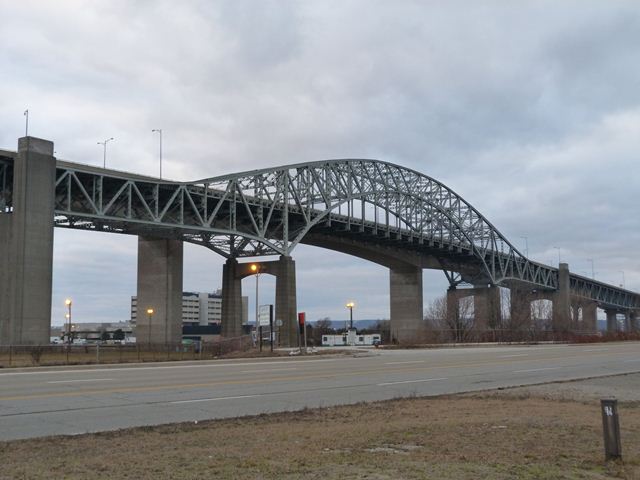We Recommend:
Bach Steel - Experts at historic truss bridge restoration.
Burlington Skyway Bridge
Burlington Bay James N. Allan Skyway Bridge

Primary Photographer(s): Nathan Holth
Bridge Documented: December 23, 2012 and June 29, 2014
Burlington and Hamilton: Halton Region, Ontario and Hamilton City, Ontario: Canada
Metal Continuous (Arch and Suspended Deck) Rivet-Connected Through Truss, Fixed and Approach Spans: Metal Rivet-Connected Warren Deck Truss, Fixed
1958 By Builder/Contractor: Hamilton Bridge Company of Hamilton, Ontario (Bridge and Tank Company of Canada) and Engineer/Design: Philip Louis Pratley
1988
495.0 Feet (150.9 Meters)
8,400.0 Feet (2560.3 Meters)
98 Feet (29.87 Meters)
3 Main Span(s)
Not Applicable

View Information About HSR Ratings
Bridge Documentation
View Historical Articles About This Bridge
This bridge is a rare surviving example in Canada of a suspended deck truss bridge. The suspended deck variety of truss has the appearance of a though arch bridge, but functions as a arch-shaped continuous through truss. The arch shape of the truss takes the truss far above the height of the deck at the center of the span, and thus the deck must be connected to this section of the truss by hangers, which is the suspended deck portion of the bridge. A high level bridge that allows freighters to pass under the fixed bridge, this bridge has a very long approach system of deck truss and deck girder spans.
The bridge has a number of unusual details. The approach spans are unusual because they include a series of spans that are supported by two alternating types of supports: traditional concrete piers and unusual riveted steel piers. It is unclear why two different supports were used. The bridge also has unusual trussed floor beams. Floor beams are more commonly solid rolled or built-up i-beams. The trussed floor beams give the underside of the bridge a unique geometric complexity.
The bridge's channel span is 495 feet (150.9 meters) while the anchor spans on either side are 275 feet (83.8 meters).
John Turner Bell was a noted Hamilton architect who assisted in the design of this bridge. The famous Philip Louis Pratley was the consulting engineer for the bridge, although he died in 1958, the year this bridge was completed.
For such a major bridge, very little online information about the history of this bridge is available. HistoricBridges.org hopes to expand this article with additional information in the future.
In 1985, this bridge was turned into part of a one way couplet of bridges with the construction of a second high level bridge at this location. Now, the heritage bridge carries traffic toward Toronto while the new bridge carries traffic toward the Niagara Region. The construction of this second bridge is sometimes described as the "twinning" of the bridge. Such a statement is highly inaccurate and misleading however. The replacement bridge is one of the ugliest bridges ever encountered, with the appearance of little more than a slab of concrete. Visually, the second bridge only serves to obstruct the view of the heritage bridge. Absolutely no attempt appears to have been made to make the second bridge compliment the heritage bridge. The second bridge is useful however as a "teaching tool" to describe how most post 1970 bridges lack aesthetics or beauty of any kind, while unaltered pre-1970 bridges usually include at least some level of aesthetic quality.
At this time, HistoricBridges.org currently only has a few overview photos for this heritage bridge.
This bridge is tagged with the following special condition(s): Unorganized Photos
![]()
Photo Galleries and Videos: Burlington Skyway Bridge
2012 Bridge Photo-Documentation
Original / Full Size PhotosA collection of overview and detail photos. This gallery offers photos in the highest available resolution and file size in a touch-friendly popup viewer.
Alternatively, Browse Without Using Viewer
![]()
2012 Bridge Photo-Documentation
Mobile Optimized PhotosA collection of overview and detail photos. This gallery features data-friendly, fast-loading photos in a touch-friendly popup viewer.
Alternatively, Browse Without Using Viewer
![]()
2014 Additional Unorganized Photos
Original / Full Size PhotosA supplemental collection of photos that are from additional visit(s) to the bridge and have not been organized or captioned. This gallery offers photos in the highest available resolution and file size in a touch-friendly popup viewer.
Alternatively, Browse Without Using Viewer
![]()
2014 Additional Unorganized Photos
Mobile Optimized PhotosA supplemental collection of photos that are from additional visit(s) to the bridge and have not been organized or captioned. This gallery features data-friendly, fast-loading photos in a touch-friendly popup viewer.
Alternatively, Browse Without Using Viewer
![]()
Maps and Links: Burlington Skyway Bridge
Coordinates (Latitude, Longitude):
Search For Additional Bridge Listings:
Additional Maps:
Google Streetview (If Available)
GeoHack (Additional Links and Coordinates)
Apple Maps (Via DuckDuckGo Search)
Apple Maps (Apple devices only)
Android: Open Location In Your Map or GPS App
Flickr Gallery (Find Nearby Photos)
Wikimedia Commons (Find Nearby Photos)
Directions Via Sygic For Android
Directions Via Sygic For iOS and Android Dolphin Browser



